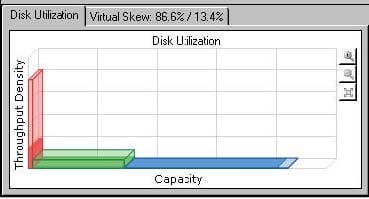Exam Details
Exam Code
:E20-326Exam Name
:Symmetrix Solutions Design Exam for Technology Architects ExamCertification
:EMC CertificationsVendor
:EMCTotal Questions
:235 Q&AsLast Updated
:Jun 29, 2025
EMC EMC Certifications E20-326 Questions & Answers
-
Question 181:
When using Timefinder/SNAP, what is true of Save devices?
A. RAID6 is the preferred protection for Save devices.
B. Save devices store the original track from the source device which is copied on first access.
C. Each Save device is recommended to be equal to or less than the largest VDEV.
D. RPQ is required to use RAID1 protection on Save devices.
-
Question 182:
Changes were made to a TimeFinder Clone after activation. The changes need to be propagated back to the source. Which method should be used?
A. Incremental restore
B. Incremental establish
C. Full restore
D. Full establish
-
Question 183:
A customer has taken four snaps of a TimeFinder/Snap source device at 10:00 a.m., 1:00 p.m.,
3:00
p.m. and 5:00 p.m. A restore operation is performed at 8:00 p.m. from the 5:00 p.m. snap session. What is the first step needed to create a snap from the same source device at 9:00 p.m.?
A.
Terminate the restored session
B.
Terminate all snap sessions
C.
Terminate the 5pm session
D.
Create a 9pm snap session
-
Question 184:
A customer wants to protect production data using local and remote replication on a pair of VMAX arrays located 500 km apart. Both VMAX arrays are fully configured with virtually provisioned thin volumes.
The customer has a Recovery Point Objective (RPO) of thirty minutes and wants to replicate the production volumes to the remote array while maintaining a separate backup copy on the local array. Which replication options do you recommend they implement?
A. TimeFinder/Clone and SRDF/A.
B. TimeFinder/Clone and SRDF/S.
C. TimeFinder/Mirror and SRDF/A.
D. TimeFinder/Snap and SRDF/S.
-
Question 185:
A customer wants to protect production data using local and remote replication on a pair of VMAX arrays located 100 km apart. Both VMAX arrays are fully configured with virtually provisioned thin volumes.
The customer has a near zero Recovery Point Objective (RPO) and wants to replicate the production
volumes to the remote array, while maintaining a separate backup copy of the production data on the local
array.
Which replication options do you recommend they implement?
A. TimeFinder/Snap and SRDF/A.
B. TimeFinder/Clone and SRDF/S.
C. TimeFinder/Mirror and SRDF/S.
D. TimeFinder/Clone and SRDF/DM.
-
Question 186:
What are the generally recommended RAID protections for Enterprise Flash Drives (EFD), Fibre Channel (FC) and Serial Advanced Technology Attachment (SATA) tiers?
A. · EFD - RAID 5 (3+1) · FC - RAID 1 · SATA - RAID 6(6+2)
B. · EFD - RAID 1 · FC - RAID 5 (3+1) · SATA RAID 6 (6+2)
C. · EFD - RAID 6 (6+2) · FC - RAID 1 · SATA RAID 5 (3+1)
D. · EFD - RAID 6 (6+2) · FC - RAID 5 (3+1) · SATA RAID 1
-
Question 187:
Refer to the exhibit.

What would you see if you place your cursor on the bottom left of the horizontal axis (green section) of the graph in Tier Advisor?
A. Recommended capacity and throughput utilization for the EFD tier
B. Recommended capacity and throughput utilization for the SATA tier
C. Recommended capacity and throughput utilization for the FC tier
D. Recommended capacity and throughput utilization for the entire configuration
-
Question 188:
Refer to the exhibit.

What would you see if you place your cursor on the bottom left of the vertical axis (red section) of the graph in Tier Advisor?
A. Recommended capacity and throughput utilization for the EFD tier
B. Recommended capacity and throughput utilization for the SATA tier
C. Recommended capacity and throughput utilization for the FC tier
D. Recommended capacity and throughput utilization for the entire configuration
-
Question 189:
What is the functional description for Tier Advisor?
A. An interactive performance modeling tool.
B. A peak performance analysis tool.
C. A tool that helps calculate DA utilization.
D. A tool that recommends the right number of VMAX engines.
-
Question 190:
You are analyzing performance data from a Symmetrix DMX populated with Fibre Channel (FC) drives with the intention of upgrading a customer to a VMAX. An analysis of the data with Tier Advisor yields a recommendation that the storage be allocated in 3 tiers, EFD, FC and SATA. What is a valid Tier advisor recommendation?
A. 10% EFD, 75% FC and 25% SATA
B. 100% EFD, 100% FC and 100% SATA
C. 5% EFD, 90% FC, 20% SATA
D. 3% EFD, 70% FC and 27% SATA
Related Exams:
D-GAI-F-01
Dell GenAI Foundations AchievementD-MSS-DS-23
Dell Midrange Storage Solutions Design 2023D-OME-OE-A-24
Dell OpenManage Operate AchievementD-PDD-DY-23
Dell PowerProtect DD Deploy 2023D-PE-OE-23
Dell PowerEdge Operate 2023D-PEXE-IN-A-00
Dell PowerEdge XE9680 and XE8640 InstallD-PSC-MN-01
Dell GenAI Foundations AchievementD-PST-MN-A-24
Dell PowerStore Maintenance AchievementD-PWF-DS-23
Dell PowerFlex Design 2023D-RP-DY-A-24
Dell RecoverPoint Deploy Achievement
Tips on How to Prepare for the Exams
Nowadays, the certification exams become more and more important and required by more and more enterprises when applying for a job. But how to prepare for the exam effectively? How to prepare for the exam in a short time with less efforts? How to get a ideal result and how to find the most reliable resources? Here on Vcedump.com, you will find all the answers. Vcedump.com provide not only EMC exam questions, answers and explanations but also complete assistance on your exam preparation and certification application. If you are confused on your E20-326 exam preparations and EMC certification application, do not hesitate to visit our Vcedump.com to find your solutions here.